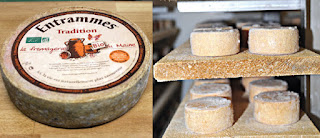from
Behind the French Menu
by
Bryan G. Newman
behindthefrenchmenu@gmail.com
Port Salut Cheese.
The Port Salut cheese comes from the department of Mayenne in the region of the Pays de Loire. The cheese is a mild, semi-soft, 27 % fat cow’s milk, cheese made with pasteurized milk and aged from 14 to 21 days. Along with Port Salut’s mild flavor comes a surprisingly strong smell when the cheese is opened; however, though that in no way detracts from the cheese’s popularity and you will see Port Salut on many cheese trolleys and cheese plates. The cheese is made in sizes of 200 grams (7 ounces), 320 grams (11 ounces), and 2.2 kilos (5 lbs).
A Port Salut pre-prepared croissant
Pre-prepared snacks of Port Salut are very popular.
Taking Port Salut home.
This cheese is made with pasteurized milk and appropriately packed will not smell on the journey home. For more about buying French cheeses and taking them home click here.
The cheese is sold with a number of names including SAFR Port Salut, Entrammes, and Saint Paulin. All the names relate to the Abbey of Notre Dame de Port Salut and its history. The cheese was created by the Trappist monks in the Abbey in 1873. The abbey may be visited and is just 16 km (10 miles) from the town of Laval, the departmental capital of Mayenne in the Pays de Loire. Just a little further down the road, 96 km (60 miles) away is the town of Lemans so famous for its 24 hours car race and the longest go-kart track in the world.
The abbey may be visited and also offers rooms for guests. They have a French language website that may be viewed in English with the Bing or Google translation apps.
Port Salut leaves the abbey.
As the Port Salut cheese became more and more popular in the 20th century, the monks could no longer produce the quantities that were being ordered. They solved that problem by selling the name and the production rights to a private company whose initials were SAFR and the so the name SAFR Port Salut is seen on the labels.
Despite the sale of the production rights of the Port Salut cheese the monks retained the right to make their cheese in smaller quantities with a different name and that was originally destined for their personal consumption. They gave that cheese the name Entrammes after the village next to the Abbey. However, that cheese also became popular and consequently again became too much for the production capacity of the Abbey which was seeing fewer and fewer monks joining. Now a local fromagerie called La Fromagerie Bio Du Maine in the village of Entrammes, next to the Abbey, makes the cheese.
The Entrammes cheese packed and aging
Producing the Entrammes Cheese.
The Fromagerie Bio Du Maine now makes the Entrammes cheese in four versions, which apart from the traditional version includes a cheese flavored with caraway seeds and another with pepper. The Fromagerie may be visited, and they have a French language website. Nevertheless, using the Bing or Google translation apps, you may view this site in English.
Port Salut on French Menus:
Tourte aux Pommes de Terre et Port Salut – Potato pie flavored with Port Salut
Suprême de Poulet Farci aux Cranberries et Fromage Port-Salut - Chicken breast stuffed with cranberries and Port Salut.
Entrammes on French Menus:
Tartine à l’Entrammes au Poivre Vert, Miel et Noix - An open sandwich made with Entrammes cheese green pepper, honey and walnuts.
Noix de Saint Jacques dans le Coquille en Croûtes d’Herbes Étuvée de Poireaux a l’Entrammes et Figues Séchées – A King scallop cooked in its shell covered with herbs and accompanied by steamed leeks, Entrammes cheese and dried figs.
Fondue a l’Entrammes au Cidre Fermier, Pommes, Boudin Blanc, Pain de Campagne – A cheese fondue made with Entrammes cheese and a farmhouse cider accompanied by apples, pork sausages and country bread.
Saint Paulin on French menus:
Légumes Farcis au Saint Paulin – Vegetables stuffed with Saint Paulin.
Saint Paulin
Saint Paulin is another cheese with a taste very similar to the Port Salut; however, this time it was not produced after being sold by the monks. It makes you wonder if someone stole the monk’s recipe! The Saint Paulin Cheese's name is not protected like the Port Salut cheese and so it is produced by a number of dairies in the North of France as well as by dairies elsewhere in Europe and in Canada.
Saint Paulin
Connected Posts:
Behind the French Menu
by
Bryan G. Newman
behindthefrenchmenu@gmail.com
Copyright 2010, 2016














